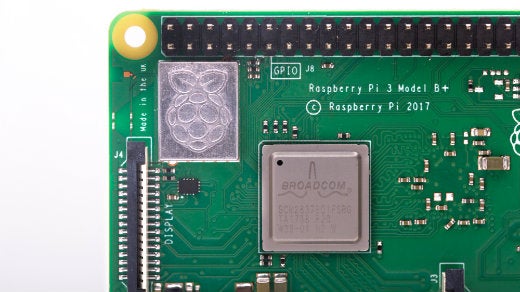Raspberry Pi just celebrated its sixth birthday—that's six years since the launch of the original Raspberry Pi. Since then, it has released various new models, including the Pi 2, Pi 3, and Pi Zero. So far, 9 million Raspberry Pi 3s have been sold—and over 18 million Pis in total—and those numbers are likely to grow following today's announcement of the Raspberry Pi 3 Model B+. This new Pi features:
- 1.4GHz 64-bit quad-core ARM Cortex-A53 CPU
- Gigabit Ethernet (over USB)
- Dual-band WiFi and Bluetooth
- Power-over-Ethernet (PoE) pins
- Improved PXE and USB booting
- Improved thermal management
This is a big update to the existing Pi 3, including a re-spin of the BCM2837 CPU (running faster at 1.4GHz), new dual-band wireless connectivity (so you can connect to both 2.4- and 5-GHz WiFi networks), better thermal control, and more. As always, you'll need an up-to-date Raspbian SD card, but the new model is backwards-compatible with all previous models and runs the same operating systems and programs. The Raspberry Pi 3 Model B+ is available now at the usual price of $35.

Gigabit Ethernet and PoE
The Raspberry Pi has always suffered an Ethernet bottleneck, throttling network speeds over USB 2.0. The new 3B+ replaces the LAN9514 USB hub with a with a LAN7515 adding Gigabit Ethernet. It's still limited by USB 2.0 but gives a 3x LAN throughput increase, which will please a lot of Pi users with network-hungry applications in the home and in industrial applications.

The addition of four new pins offset from the main GPIO header provides support for Power-over-Ethernet. An official HAT (add-on board) has been designed to provide this feature natively, and it will be released soon.
The original Raspberry Pi 3 was the first Pi board to support multiple boot modes (an alternative to regular booting from the SD card)—including PXE network booting and booting from USB mass storage devices. This means you can boot Raspbian from a USB hard drive, which has faster disk I/O than an SD card.
The PiServer tool, launched in December, provides simple Raspberry Pi network management. This means you can manage a cluster of Raspberry Pi 3s on a wired network, and the Pis don't need SD cards inserted as they boot remotely into a managed operating system image. This is ideal for classrooms, handy in the home, and can even be used to manage factory automation processes in industrial applications.
The 3+ also supports netbooting, and some minor bugs in the bootrom, found in the Pi 3 after rollout, have been fixed.
Thermals and power management
Over the years, as the Raspberry Pi became more powerful and increased its CPU speed, it became more power-hungry and tended run hotter. The 3+ improves power regulation, allowing the Pi to run happily at 1.4GHz when the CPU is under 70°C, and it decreases the core voltage and drops to 1.2GHz above 70°C before throttling at 80°C, but the improved power management should prevent it from reaching this point.
With Raspberry Pi 1 you could get away with using low-power mobile phone chargers. Although some of them can manage to boot the Pi 3 and 3+ ok, they likely won't stand up to intensive applications that draw lots of power, so a quality 2.5A power supply is recommended.
What can you do with it?
There are many applications for Raspberry Pi: it's used heavily in education (in schools and in coding clubs), in the home (see 5 projects for Raspberry Pi at home), and in industry. Many people use Pis for media centers and home automation projects or just for learning about code and building hardware projects. You can do physical computing and camera projects. Check out the getting started guide, read up on which Raspberry Pi to choose for your project, and take a look at this selection of Raspberry Pi add-on boards. Learn how to set up Postgres on the Pi and write a Twitter bot with Python!
Get involved with the Raspberry Pi Foundation
The Raspberry Pi Foundation is not just a hardware company. It's primarily an educational charity with the aim of putting the power of digital making into the hands of people all over the world. Making affordable, programmable computers is just one of the things the Foundation does to help with this goal.
Last weekend, the Raspberry Jam Big Birthday Weekend took place, and over 120 Jam events took place around the world. Check out the round-up of these events, and see how to run a Raspberry Pi meetup in your community.
Raspberry Jam Big Birthday Weekend
You can also give young people an opportunity to learn about coding and digital making by starting a Code Club or CoderDojo near you.







7 Comments